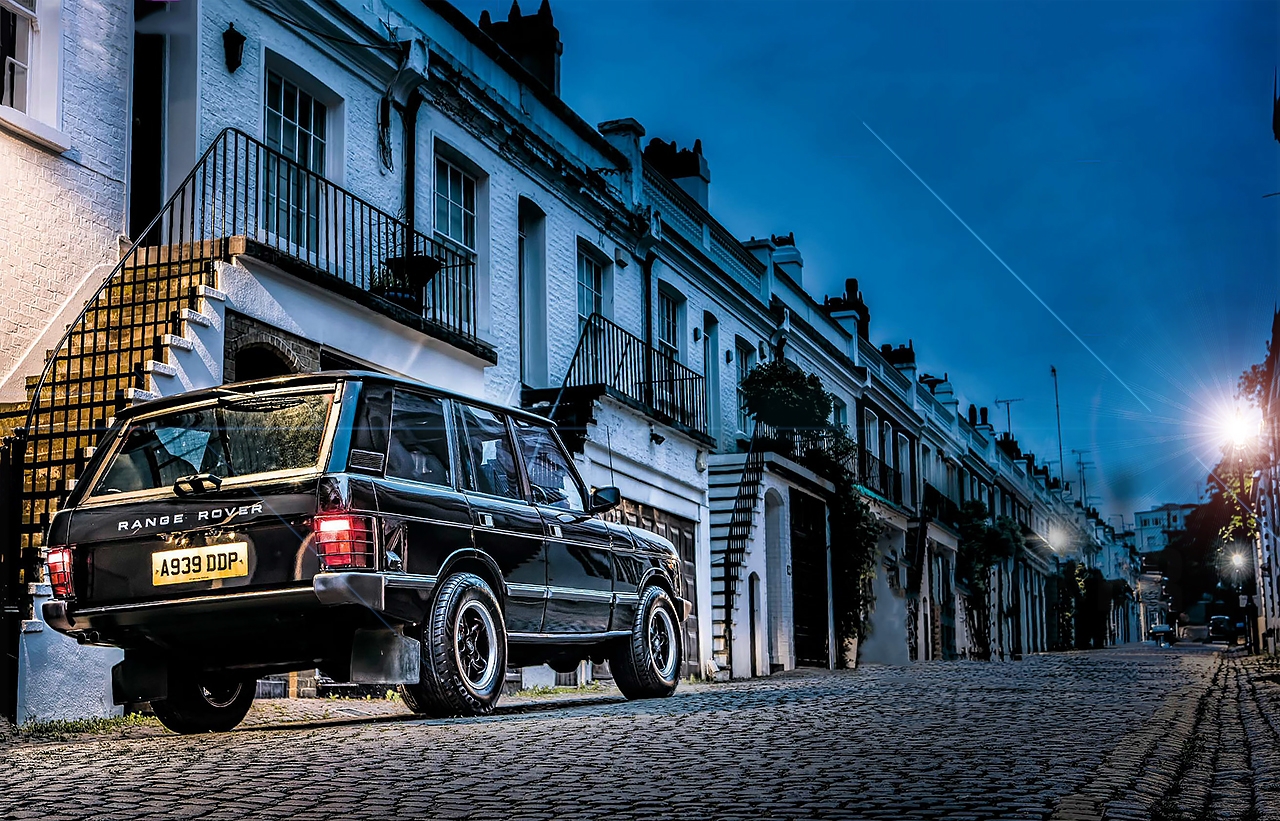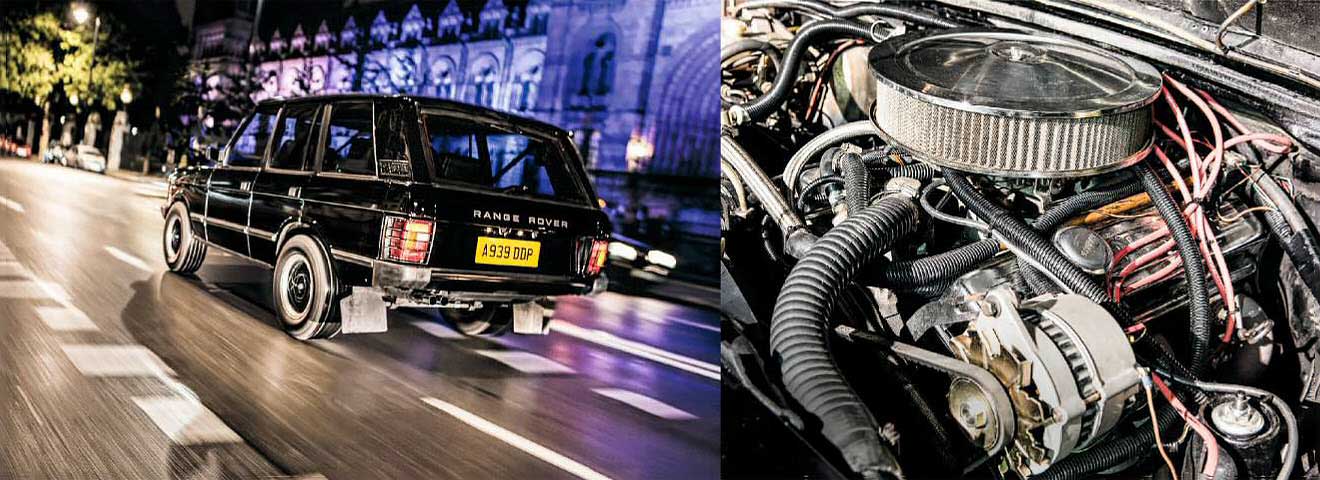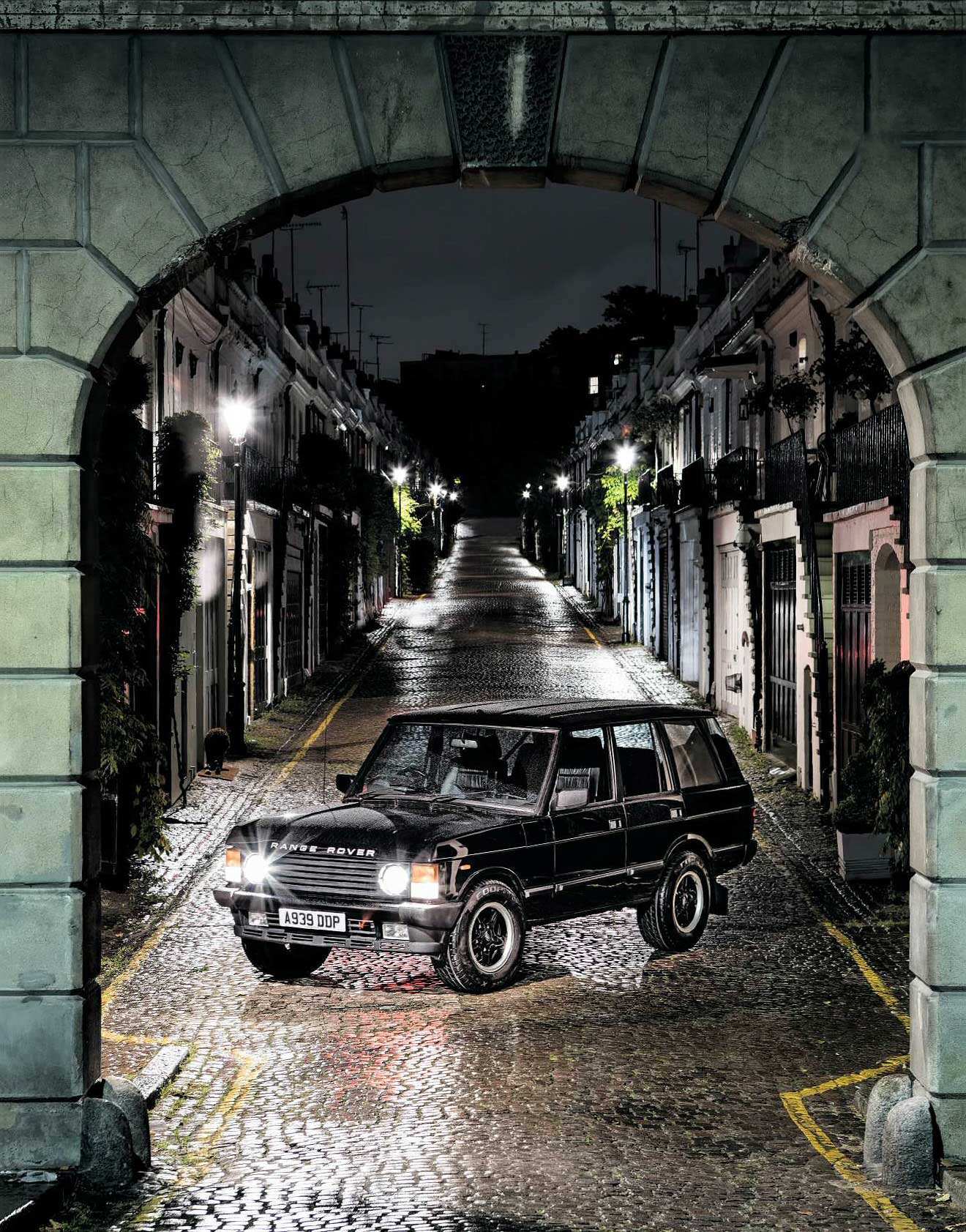
Range cooker tuned heroes. Driving an astonishing Overfinch-tuned Range Rover in its most natural stomping ground – west London. At night. We’re in love. The modern sporty SUV has its origins in a vibrant mix of British coachbuilding and USA V8 throb. We take the Overfinch 570i back to its natural London stomping ground. Words Keith Adams. Photography Neil Fraser.
The moonlit and mean streets of west London are moodier than we remember. The sodium lighting casts a yellowish tinge, and everywhere is deserted. It could almost be haunting, if we weren’t playing a cassette of Phil Collins’ In The Air Tonight, while prowling menacingly in that ultimate symbol of 1980s excess, a tuned Range Rover.
But this is no mere ‘tuned’ car. The Overfinch 570i was more of a way of life. Enthusiasts of a certain age will remember the discreet advert posted towards the back of CAR magazine, which depicted its over-powered tuned Range Rover trading punches with a Porsche 911 Turbo. If that didn’t catch your attention, then being mugged by one on the Kings’ Road in 1988 certainly will have done.
Today, of course, the idea of an off-roader that can deliver sports-car punch is prety mainstream. The Range Rover Sport or Jaguar F-Pace will both post reasonable times on the Nürburgring Nordschliefe – if that’s your thing. But in an era when you could still buy a Citroën 2CV or Reliant Rialto new, and Porsche still exclusively built two-door sports cars, a hyper-performing Range Rover was the stuff of pure fantasy.
But this is reality. And it’s impossible not to love the Overfinch 570i. Even before we climb in and fire up its V8, we were enamoured by its understated looks. The fact it’s unadorned by the chintz that many of these cars attracted (and still do) serves to remind us how right Rover got this car back in 1970, and how – for many – it remained one of the most relevant cars of the ’80s. In London, anyway.
Overfinch’s association with Range Rovers is a long one. Founded by Arthur Silverton and originally known as Schuler UK (part of an international parts supply and engineering company), its first conversion, launched in 1975, was a quadcarb upgrade for the Range Rover, giving it a little more punch. Strong interest from frustrated owners who wanted to use their car primarily on the road, and who desired more power, led Schuler to pursue alternative avenues. A year later, its 4.4-litre Leyland P76 V8-powered Range Rover, boasting 190bhp, made quite a splash. The era of faster, more bespoke Range Rovers had begun in earnest.
Schuler’s work on Range Rovers took a more innovative turn, having uncovered such untapped potential in this underdeveloped car. It came up with an optional ABS set-up before Land Rover, and even offered improved five-speed manual and automatic gearboxes.
When the Range Rover was conceived in the late 1960s by Spen King and Gordon Bashford as a more luxurious form of off-roader, BL had been negligent (through a lack of money) in developing this hugely successful car to meet the demands of their customers. The ingredients were there, but what they wanted was faster, more road-focused Range Rovers, with more equipment and style, as well as an automatic option and four doors.
That lack of in-house development left the door open for enterprising companies such as Schuler to improve the Range Rover and earn loads of money fromit instead. By the early 1980s, BL had learned this lesson and was working closely with Schuler – and other companies, too – to improve the Range Rover. It started by offering Schuler-developed Chrysler TorqueFlite automatic gearboxes as a factory-approved optional extra.
This, and other ventures based on the Range Rover, kept Schuler busy until 1985, when the company was hived off from its parent and rebranded. Overfinch was born.
Between then and when the original company went into administration in 2010, it specialised in producing increasingly powerful bespoke-build Range Rovers, powered by GM-sourced V8s. The car in which we’re rumbling through London tonight is a typical mid-build Classic. It’s a 570i conversion, carried out on a 1984 four-door, currently on sale with Graeme Hunt for £29,950.
If you think that’s dear for a Rangie, then you’ve not been following the market closely – with early, storied two-doors commanding more than £80,000, and late CSK special editions at around £50,000, this fast and understated car looks good value.
Well, it does if you’re not an originality fiend – given how ingrained Overfinch is in the Range Rover world, it’s more akin to buying an AC Schnitzer BMW or a Brabus Mercedes-Benz.
Whatever your opinions are on the relative merits of crowbarring a Corvette engine into a Rangie, this is an epic car. We love the unassuming way this one looks. It works beautifully in black, especially as it’s been recently resprayed.
And doesn’t it look all the better for not wearing the OVERFINCH stencilling on the bonnet, which the first owner clearly didn’t want. If you’re going to smoke 911s and GTIs from the lights, you may as well surprise their drivers, too.
Inside, it’s an interesting mix. Being based on a 1984 car, the interior combines bespoke high-end leather upholstery with a creaking dashboard, Austin Rover switchgear and an instrument pack lifted straight from an early Austin Maestro. But, in black, with matching rooflining, it looks great. Allied with those big windows and slim pillars, it doen’t feel claustrophobic at all in a colour palette that would leave most cars looking like a coal bunker.

Roaring Chevrolet V8 chucks out 284bhp – and oodles of glorious shock and awe.
Sit inside, soak in the imperious driving position and fire it up before you’re tempted to kick back and tune into Radio 3. The Chevrolet V8 awakes and grumbles into a chuntering idle that serves to remind you it’s far from standard.
Snick the selector into D, and tease the throttle for a gentle getaway. For Overfinch newbies, it’s always good to take things slowly initially, especially considering their fearsome reputation.
But here’s the thing – acclimatisation comes quickly. Far more so than you’d expect, which is probably a good sign. Long before you’ve explored that long-travel throttle, its steering will blow you away.
Old hands at Range Rovers will tell you that they are indecisive, rather vague creatures to drive. But this one is something else again – the small, thickrimmed wheel telegraphs oodles of feedback, and where there was once slop, you’re met with direct response. Clearly, it comes with the Overfinch-developed Precision Steering Conversion (£485 on top of the basic £7k conversion cost), which comprises a re-engineered linkage. However it works, it changes the character of the car.
Get it out on to a road where you can build up more speed, and the overall impression is of a tighter, stiffer Range Rover, one with less wander or floatiness. As we head out of London, and towards the deserted A10, we get an opportunity to find the beating heart of the Overfinch.
Despite the message delivered by the contemporary advertising, this is no performance car. The twists and turns as we head north soon reveal that. Its steering tugs as the transmission tries to work out which wheel it needs to send its torque to at one time, which made it seem a little on the inconsistent side for press-on drivers.
The stiffened suspension that does much to quell the body wander does have a nasty side-effect, too. It clangs and clatters over bumps, an irritation we can’t help but suffer time and again as we thread our way through London. It’s a car clearly built in a time before speed humps were a thing.
On B-roads, potholes can also alter your course in bends, which makes that tighter steering all the more relevant. But as this is no 205 GTI, you’re going to drive it accordingly, anyway. Aren’t you?
To the dual-carriageways heading for the city, and it once again comes into its own. Pressing the throttle fully evokes a strange and not unexpected reaction – there’s a momentary pause, as if the car is gathering its strength for the upcoming task, rather like a butler asking: ‘Are you sure, sir?’
Then, it kicks down, and its immense power and torque are unleashed in a bellowing, truly riotous, V8 roar. All foibles, criticisms and irritations are forgotten, and you’re in the zone – which, 25 years ago, would leave you hammering past the hoi polloi in their Montegos and Cavaliers, laughing as you go.
Today’s reality is a little more muted in terms of accelerative thrust. Yes you’re going quickly, but really that much more quickly than a standard 3.9?
Modern Classics view
The Overfinch 570i is a wonderful thing. It’s a Range Rover Classic, taken to 120%, and we love it for that. It’s a politically incorrect riot of a car – as imperfect as can be for the city most of its owners lived in. It’s a car that’s built for the Britain we fondly remember before the advent of the GATSO, when petrol was 50p per litre and you could smoke in pubs. As a car for a blast from your London pad to the country pile, it made a lot of sense – there’s lots of room for the shotguns, Barbour jackets and Labradors.
As a Modern Classic today, the Overfinch cuts the mustard, big time – as long as your pockets are deep, and you keep your miles down. Graeme Hunt’s example is pristine, and you get what you pay for, so you can buy cheaper ones. But it’s not the buying cost that will dampen the ownership experience, it’s the fuel consumption that’s going to hurt the most.
If you can stand that, running costs won’t be too much different to a standard Range Rover. US V8 servicing is simple, with excellent parts supply. Values will go up in line with other Range Rovers, too, but it’s unlikely they’ll exceed the standard car. But does that matter? If you can stump up the fuel bills, you’re in for a blast…

From here to modernity – the Overfinch helped make fast SUVs cool.
SPECIFICATIONS
Engine 5734cc/V8/OHV
Power 284bhp @ 4900rpm
Torque 345lb ft @ 3000rpm
Maximum speed 125mph
0-62mph 9.0sec
Fuel consumption 15-17mpg
Transmission Four-speed auto, four-wheel drive
WHAT TO PAY
Concours £40,000
Good £30,000
Usable £20,000
Project £10,000
OVERFINCH: MASTERS OF THE OPTIONS LIST
It’s 1994 and you want your ultimate Range Rover to have all the toys in the box attached to it. Overfinch could do that for you, and what colour would you like it in, sir? There were several levels of conversion you could go for. The 500/570i upgrade cost between £5000-£7000 and amounted to the 5.0- or 5.7-litre V8 Chevrolet engine, and little else.
Spending £13k on a 570Ci brought you a little more power, blueprinting and a stainless exhaust, while the £17k 570Ti conversion upped the game to 330bhp.
Then there were options – £1600 for uprated suspension, £600 for an uprated autobox package and £650 for vented discs. Overfinch offered upgrade paths that the major manufacturers do today. Dualtone L405, anyone?
‘We love the unassuming way it looks – it’s so much better for not wearing its Overfinch badges’
Plenty to mews on – if you’re a 911 driver wondering why you can’t lose that pesky Range Rover on the motorway…






